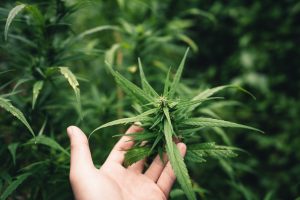
One of the most important things to understand about cannabis is that there are many different strains, each with its own unique combination of cannabinoids, terpenes, and other compounds. Some of the most common strains include Indica, Sativa, and Hybrid.
Indica strains are typically associated with relaxing effects and are often used for pain relief and anxiety. Sativa strains, on the other hand, are associated with more energizing effects and are often used for mood enhancement and creativity. Hybrid strains are a combination of Indica and Sativa and can produce a range of effects depending on the specific strain.
One of the main reasons for these different effects is the presence of cannabinoids, which are the chemical compounds found in cannabis that interact with the body’s endocannabinoid system. The two most well-known cannabinoids are THC and CBD.
THC, or tetrahydrocannabinol, is the psychoactive compound that produces the “high” feeling often associated with cannabis use. It is typically found in higher concentrations in Sativa strains.
CBD, or cannabidiol, is a non-psychoactive compound that is known for its anti-inflammatory and pain-relieving properties. It is typically found in higher concentrations in Indica strains.
In addition to cannabinoids, cannabis also contains terpenes, which are the aromatic compounds responsible for the distinct smells and flavors of different strains. Terpenes can also interact with the body’s endocannabinoid system and produce a range of effects.
Now that we’ve covered the basics of different cannabis strains and their effects, let’s take a look at some common methods of consumption.
Smoking is one of the most common methods of consuming cannabis. This can be done through a joint, a pipe, or a bong. When cannabis is smoked, the active compounds are absorbed into the bloodstream through the lungs, producing effects within minutes.
Vaporizing is another popular method of consuming cannabis. This involves heating the cannabis to a temperature that releases the active compounds without burning the plant material. Vaporizing is often considered to be a healthier alternative to smoking, as it produces less harmful byproducts.
Edibles are another popular method of consuming cannabis. These can come in the form of baked goods, candies, or drinks. When cannabis is consumed orally, it takes longer for the effects to be felt, as the active compounds must first be metabolized by the liver. This can take anywhere from 30 minutes to 2 hours, depending on the individual and the amount consumed.
Topicals are another method of consuming cannabis that is becoming increasingly popular. These are products that are applied directly to the skin, such as lotions or balms. When cannabis is applied topically, it is absorbed through the skin and can produce localized pain relief or anti-inflammatory effects.
It’s important to note that the effects of cannabis can vary widely depending on the individual, the method of consumption, and the specific strain. It’s also important to use cannabis responsibly and in accordance with local laws and regulations.
In conclusion, cannabis is a fascinating plant with a wide range of strains and effects. Understanding the basics of different strains, how they affect the body, and common methods of consumption can help users make informed decisions and have a positive cannabis experience. As always, it’s important to use cannabis responsibly and in accordance with local laws and regulations.
Cannabis, also known as marijuana, has been used for its medicinal and recreational properties for centuries. With the recent legalization of cannabis in many parts of the world, there has been a renewed interest in understanding the basics of this fascinating plant.
One of the most important things to understand about cannabis is that there are many different strains, each with its own unique combination of cannabinoids, terpenes, and other compounds. Some of the most common strains include Indica, Sativa, and Hybrid.
Indica strains are typically associated with relaxing effects and are often used for pain relief and anxiety. Sativa strains, on the other hand, are associated with more energizing effects and are often used for mood enhancement and creativity. Hybrid strains are a combination of Indica and Sativa and can produce a range of effects depending on the specific strain.
One of the main reasons for these different effects is the presence of cannabinoids, which are the chemical compounds found in cannabis that interact with the body’s endocannabinoid system. The two most well-known cannabinoids are THC and CBD.
THC, or tetrahydrocannabinol, is the psychoactive compound that produces the “high” feeling often associated with cannabis use. It is typically found in higher concentrations in Sativa strains.
CBD, or cannabidiol, is a non-psychoactive compound that is known for its anti-inflammatory and pain-relieving properties. It is typically found in higher concentrations in Indica strains.
In addition to cannabinoids, cannabis also contains terpenes, which are the aromatic compounds responsible for the distinct smells and flavors of different strains. Terpenes can also interact with the body’s endocannabinoid system and produce a range of effects.
Now that we’ve covered the basics of different cannabis strains and their effects, let’s take a look at some common methods of consumption.
Smoking is one of the most common methods of consuming cannabis. This can be done through a joint, a pipe, or a bong. When cannabis is smoked, the active compounds are absorbed into the bloodstream through the lungs, producing effects within minutes.
Vaporizing is another popular method of consuming cannabis. This involves heating the cannabis to a temperature that releases the active compounds without burning the plant material. Vaporizing is often considered to be a healthier alternative to smoking, as it produces less harmful byproducts.
Edibles are another popular method of consuming cannabis. These can come in the form of baked goods, candies, or drinks. When cannabis is consumed orally, it takes longer for the effects to be felt, as the active compounds must first be metabolized by the liver. This can take anywhere from 30 minutes to 2 hours, depending on the individual and the amount consumed.
Topicals are another method of consuming cannabis that is becoming increasingly popular. These are products that are applied directly to the skin, such as lotions or balms. When cannabis is applied topically, it is absorbed through the skin and can produce localized pain relief or anti-inflammatory effects.
It’s important to note that the effects of cannabis can vary widely depending on the individual, the method of consumption, and the specific strain. It’s also important to use cannabis responsibly and in accordance with local laws and regulations.
In conclusion, cannabis is a fascinating plant with a wide range of strains and effects. Understanding the basics of different strains, how they affect the body, and common methods of consumption can help users make informed decisions and have a positive cannabis experience. As always, it’s important to use cannabis responsibly and in accordance with local laws and regulations.





